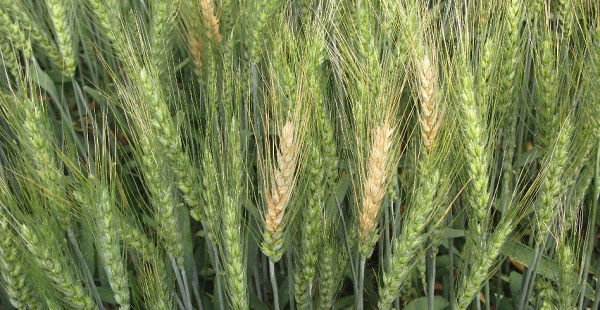Be Ready for Any Scenario This Season with Prosaro® PRO Fungicide
June 4, 2023

If the conditions are favorable, fungal disease can arrive at any time during the growing season. To prevent damage and yield loss, you should be ready to manage any disease scenario that may come up. Having a fungicide with proven performance in mind can help you be ready to prevent and control disease, while also protecting grain quality.
Be Ready for Any Disease Scenario with Prosaro® PRO
Fungal disease can have a significant impact on grain yields and quality in cereal crops. To be ready for any disease scenario, you should be aware of and prepared to manage the following diseases:
Fusarium head blight
Fusarium head blight, also known as scab is a fungal disease that contributes to yield loss from floret sterility and the production of shriveled, light test-weight kernels. Scab can also lead to diminished grain quality, due to the presence of mycotoxins, such as deoxynivalenol, or DON, in the kernels. In some cases, this grain may be unacceptable for purchase at the elevator. However, a well-timed fungicide application may help reduce damage. Reductions in severity of 50-60 percent can occur when a fungicide application is made at early flowering in wheat.i
Septoria leaf blotch
While septoria leaf blotch can infect plants at any stage of development, it tends to be more common early on in the season. Symptoms are first detected on the lower leaves, after extended periods of leaf wetness. During periods of rainy weather, the disease rapidly spreads from the lower to upper leaves.ii Septoria leaf blotch can cause yield losses up to 30 percent.iii
Rust diseases
Rust diseases can be economically damaging in cereal crops. With windborne spores, rusts can easily spread and travel long distances, rapidly developing when the weather conditions are favorable.
Leaf rust is the most common of the rust diseases in wheat-growing regions of the United States. In spring wheat, yield losses of 30 to 40 percent have been documented when severe infection occurred before flowering and the damage on the flag leaf was greater than 60 percent. The greatest response to leaf rust control has been when fungicides are applicated at flag leaf through early flowering.iv
Stripe rust can also be damaging to cereal crops, causing yield loss up to 30 percent in susceptible varieties. Stripe rust tends to attack wheat plants at a younger stage than leaf rust, so scouting early is important. If two-to-five percent rust develops on a susceptible variety a fungicide application is warranted to manage the disease.v
Tan spot
Tan spot is caused by a parasitic fungus and is most severe in continuously cropped wheat fields. Yield and quality reductions are proportional to the amount of leaf area affected, particularly the flag leaf.vi
Glume blotch
Glume blotch begins on the lower leaves within the crop canopy and moves upward to the heads, if weather remains favorable. This disease can result in yield losses between 10 and 20 percent with greatest losses occurring when there is damage to both the leaves and the heads. If heads are infected with glume blotch, the resulting grain may be small and shriveled. Foliar fungicides can protect wheat against glume blotch but must be applied shortly after head emergence.vii
Bayer Solution
Fungicides are an important tool to rely on for protecting yields and grain quality from disease. Prosaro® Pro fungicide can help you be ready for any disease scenario this season.
With three effective active ingredients, Prosaro PRO provides broad spectrum control of many diseases including Fusarium head blight (scab), leaf, stem and stripe rusts, glume blotch, tan spot and powdery mildew. Prosaro PRO can help improve grain quality and maximize yield potential, increasing your profit potential.
To learn more about Prosaro Pro fungicide and the diseases it controls, contact your local Bayer Cereal Expert or visit ProsaroPRO.com.
ALWAYS READ AND FOLLOW PESTICIDE LABEL DIRECTIONS. Not all products are registered for use in all states and may be subject to use restrictions. The distribution, sale, or use of an unregistered pesticide is a violation of federal and/or state law and is strictly prohibited. Check with your local dealer or representative for the product registration status in your state. Bayer and Prosaro® are registered trademarks of Bayer Group. For additional product information call toll-free 1-866-99-BAYER (1-866-992-2937) or visit our website at www.BayerCropScience.us. Bayer CropScience LP, 800 North Lindbergh Boulevard, St. Louis, MO 63167. ©2023 Bayer Group. All rights reserved.
Works Cited
i Friskop, A. and Zhong, S. “Fusarium Head Blight (Scab) of Small Grains.” North Dakota State University, 2018. https://www.ag.ndsu.edu/publications/crops/fusarium-head-blight-scab-of-small-grains
ii Salgado, J.D. and Paul, P.A. “Leaf Blotch Diseases in Wheat – Septoria tritici Blotch, Stagonospora nodorum Blotch and Tan Spot.” Ohio State University Extension, 2019.
iii Gloves, C. and Smith, D.L. “Disease Profile – Leaf Blotch Diseases of Wheat.” University of Wisconsin-Madison Integrated Pest and Crop Management, 2013.
iv Friskop, A. and Acevedo, M. “Rust Diseases of Wheat in North Dakota.” North Dakota State University, 2015.
v “Stripe rust.” Washington State University Extension, 2018. http://smallgrains.wsu.edu/disease-resources/foliar-fungal-diseases/stripe-rust/
vi McVay, K., Burrows, M., Jones, C., Menalled, F. and Wanner, K. “Montana Wheat Production Guide.” Montana State University Extension, 2017. http://msuextension.org/publications/AgandNaturalResources/EB0197.pdf
vii “Glume blotch on wheat.” Ag Professional, 2011.